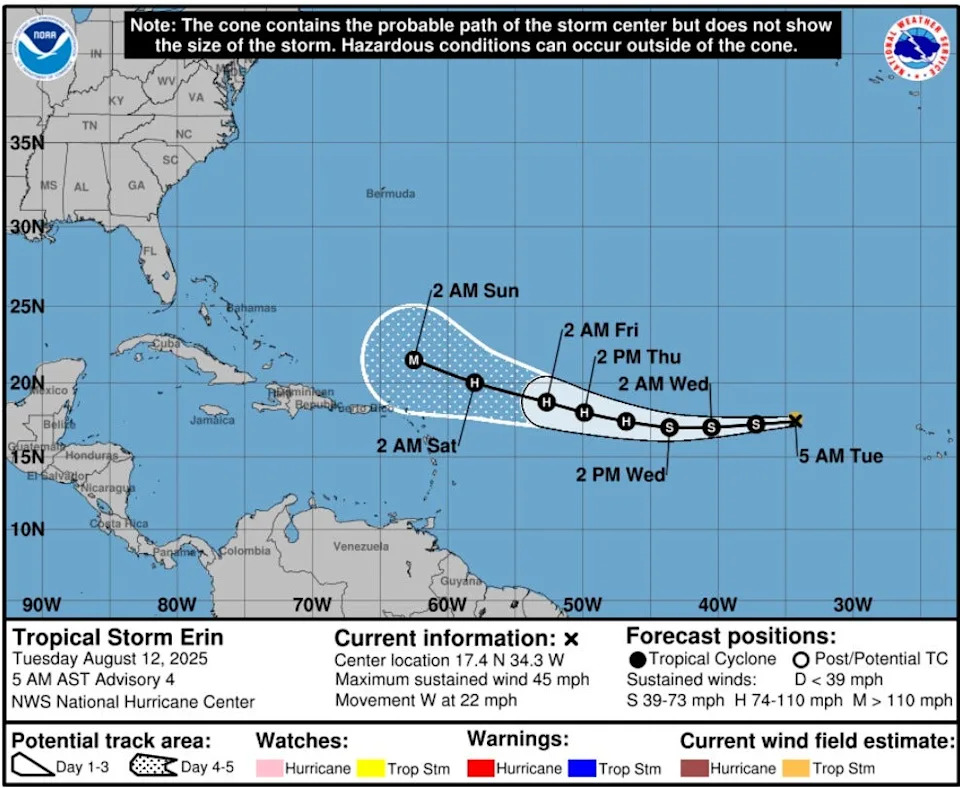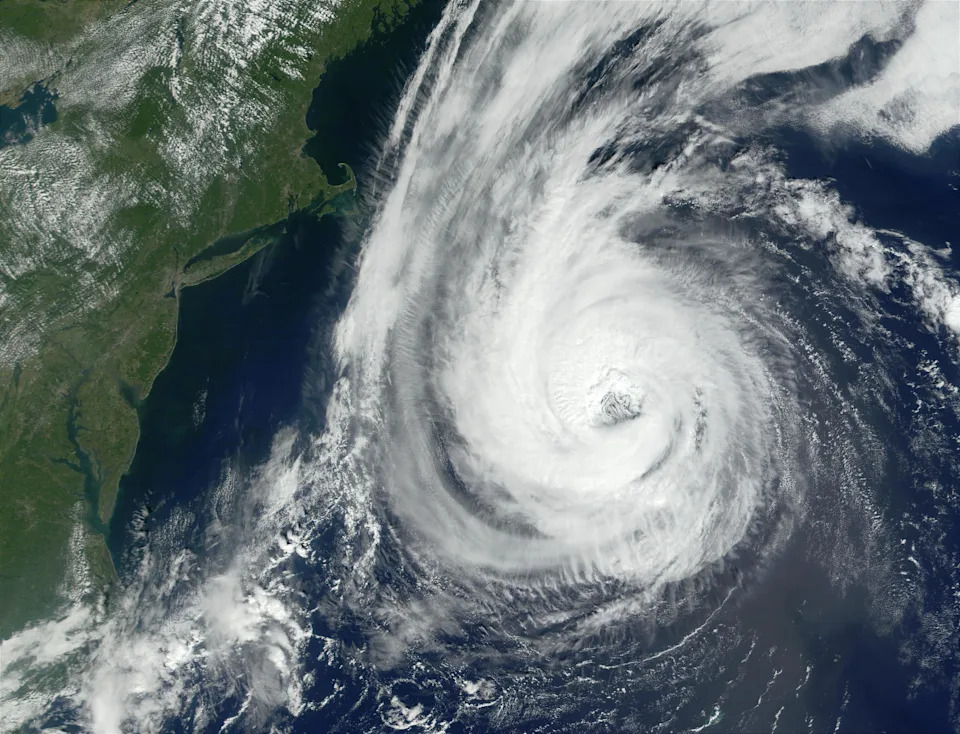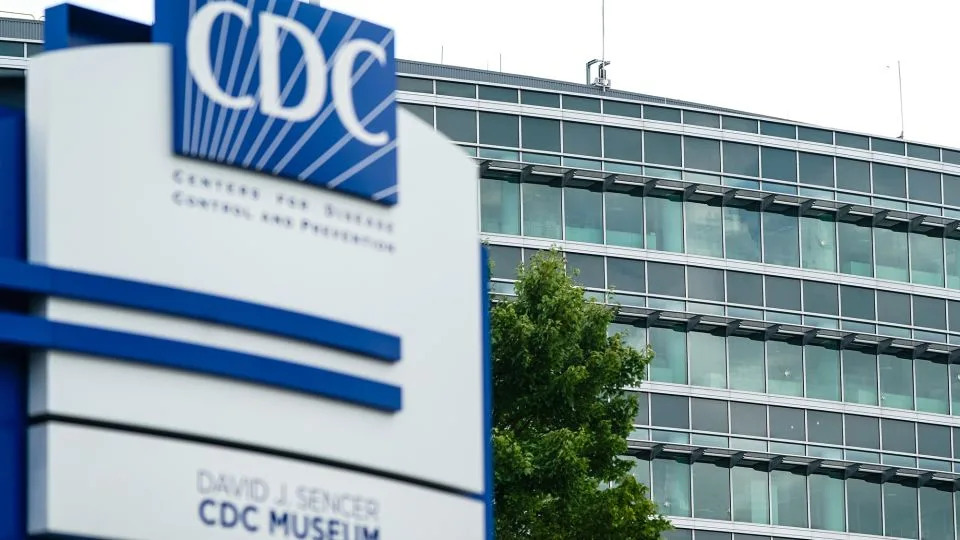Tropical Storm Erin is expected to strengthen in the Atlantic and likely become the first hurricane of the Atlantic season, according to the National Hurricane Center.
As of 5 a.m., the storm is located 690 miles west of the Cabo Verde Islands in the Atlantic with wind speeds of 45 mph. The storm is moving eastward at 22 mph and is expected to continue west before making a west-northwest turn over the next few days.
Here's what we know about the storm.
Will Tropical Storm Erin become a hurricane?
The storm is expected to gain strength and become a hurricane late Aug. 13 or early Aug. 14. As the storm moves further west, it may become a major hurricane this weekend.

Will Tropical Storm Erin impact Delaware?
It's too soon to tell. There are no coastal watches or warnings in effect at this time. According to AccuWeather.com, the path of the storm will depend on the jet stream.
“Erin will be guided westward by the Bermuda high through the Atlantic this week. There are two key factors that will determine which route this storm takes by the end of this weekend. The positioning of the Bermuda high and the strength of a cold front pushing off the East Coast will eventually determine whether this storm steers away from the U.S. and back out to sea or if it barrels through the front and continues westward,” AccuWeather Lead Hurricane Expert Alex DaSilva said in a release. “A dip in the jet stream over the eastern U.S. may also influence the track of this storm.”
If the dip in the jet stream moves eastward quickly, the storm could be pushed northwest and into the Atlantic. If it moves slowly. the storm could impact the East Coast.
What do the spaghetti models look like for Tropical Storm Erin?
Special note about spaghetti models: Illustrations include an array of forecast tools and models, and not all are created equal. The hurricane center uses only the top four or five highest performing models to help make its forecasts.
When was the last Hurrican Erin?
The last time a Hurricane Erin occurred was in 2001. The storm became a hurricane on Sept. 9. Erin was off the East Coast near New York on Sept. 11. NASA satellite images of the hurricane show smoke from the World Trade Centers blowing south.

When is hurricane season?
Hurricane season runs from June 1 through Nov. 30. However, hurricanes can occur before and after those dates.
When is the peak of hurricane season?
The peak of the season is Sept. 10, with the most activity happening between mid-August and mid-October, according to the hurricane center.

What are the categories for tropical cyclones and hurricanes?
Tropical storm
A tropical storm is a tropical cyclone with winds between 39 and 73 mph. These storms bring heavy rains that could lead to dangerous flooding.
Category 1
A category 1 storm is the weakest of the hurricanes with winds between 74-95 mph. The storm will cause some flooding, but no real structural damage.
Category 2
A category 2 storm has winds between 96-110 mph. The storm can cause moderate damage to buildings.
Category 3
A category 3 storm will have winds from 111-129 mph. It can cause major damage to well-built framed homes, uproot trees and cause power and communication outages.
Category 4
A category 4 storm can cause catastrophic damage to well-built framed homes, tearing off roofs and breaking exterior walls. Mobile homes are destroyed. Roads are impassible and there are communication and power outages.
Category 5
A category 5 storm can cause catastrophic damage with most framed homes and mobile homes being destroyed. Trees will be snapped and uprooted. Roads will be impassible and there will be extended power and communication outages.
Here is the list of names for the 2025 Atlantic hurricane season
The names are given out in alphabetical order, and each new storm gets the next name on the list. There are no Q, U, X, Y, or Z names because of the lack of names that begin with those letters. So far this season, Andrea through Erin have been used on tropical storms.
Here's how to pronounce all of the 2025 hurricane names.
Andrea
Barry
Chantal
Dexter
Erin
Fernand
Gabrielle
Humberto
Imelda
Jerry
Karen
Lorenzo
Melissa
Nestor
Olga
Pablo
Rebekah
Sebastien
Tanya
Van
Wendy
Prepare now for hurricanes
Delaying potentially life-saving preparations could mean waiting until it’s too late. "Get your disaster supplies while the shelves are still stocked, and get that insurance checkup early, as flood insurance requires a 30-day waiting period," the National Oceanic and Atmospheric Administration recommends.
Develop an evacuation plan: If you are at risk from hurricanes, you need an evacuation plan. Now is the time to begin planning where you would go and how you would get there.
Assemble disaster supplies: Whether you’re evacuating or sheltering-in-place, you’re going to need supplies not just to get through the storm but for the potentially lengthy aftermath, NOAA said.
Get an insurance checkup and document your possessions: Contact your insurance company or agent now and ask for an insurance check-up to make sure you have enough insurance to repair or even replace your home and/or belongings. Remember, home and renters insurance doesn’t cover flooding, so you’ll need a separate policy for it. Flood insurance is available through your company, agent, or the National Flood Insurance Program. Act now, as flood insurance requires a 30-day waiting period.
Create a family communication plan: NOAA said to take the time now to write down your hurricane plan, and share it with your family. Determine family meeting places, and make sure to include an out-of-town location in case of evacuation.
Strengthen your home: Now is the time to improve your home’s ability to withstand hurricane impacts. Trim trees; install storm shutters, accordion shutters, and/or impact glass; seal outside wall openings.
Doyle Rice contributed to this story
This article originally appeared on Delaware News Journal: When will Tropical Storm Erin become a hurricane? Here's the forecast








Comments